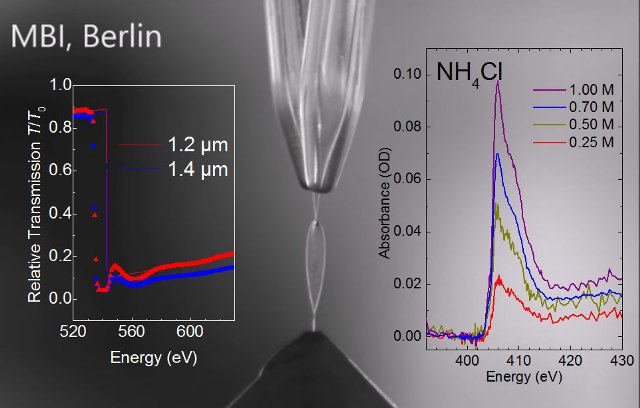Aug 25 2015
A major advance in solution phase soft-x-ray spectroscopy has been achieved utilizing a new liquid flatjet system, paving the way for novel steady-state and time-resolved experiments.
 Liquid flatjet system, showing the two nozzles from which two impinging single jets form a 1 mm wide and 5 mm long liquid water sheet with a thickness of 1 - 2 ìm as determined by measuring the transmission at the oxygen K absorption edge (left), with which XAS measurements in transmission can be made on aqueous solutions, as exemplified with the nitrogen K absorption edge spectrum of ammoniumchloride (right). (c) MB
Liquid flatjet system, showing the two nozzles from which two impinging single jets form a 1 mm wide and 5 mm long liquid water sheet with a thickness of 1 - 2 ìm as determined by measuring the transmission at the oxygen K absorption edge (left), with which XAS measurements in transmission can be made on aqueous solutions, as exemplified with the nitrogen K absorption edge spectrum of ammoniumchloride (right). (c) MB
Element-specific x-ray methods play a key role in determining the atomic structure and composition of matter and functional materials. X-ray spectroscopy is sensitive to the oxidation state, the distances, coordination number and species of the atoms immediately surrounding the selected element. A large variety of x-ray spectroscopic techniques have been applied to gas-phase, bulk liquid or solid-state samples, or have been used to probe molecular systems at interfaces. X-ray spectroscopy is predominantly done at large-scale synchrotron facilities, or in more recent years with x-ray free electron lasers, probing steady-state and time-resolved material properties.
Solution phase soft-x-ray absorption spectroscopy (XAS, energy range approximately from 0.2 - 1.5 keV) is not an easy method: experiments need to be done under vacuum conditions, an environment obviously incompatible with the high vapor pressure of water. Furthermore, if measured in transmission, absorption cross sections demand sample thicknesses in the micrometer and submicrometer range (1 micrometer = 10-6 m = one millionth of a meter). Alternatively, if secondary signals such as x-ray fluorescence are measured, the experiment is limited to comparably large solute concentrations. Using sample cells with thin membrane windows enables control of appropriate sample thicknesses, but sample degradation upon x-ray illumination (or upon pump laser illumination in time-resolved experiments) makes this approach disadvantageous for photolabile molecular systems. Sample refreshment is possible with a liquid jet, generated by pumping a solution through a nozzle with a small orifice, into the vacuum chamber. Single liquid jets have, however, difficulties to implement the required (sub)micron thicknesses.
A collaboration between scientists from the Max Born Institute for Nonlinear Optics and Short Pulse Spectroscopy (MBI), the Helmholtz-Zentrum Berlin (HZB) and the Max Planck Institute for Dynamics and Self-Organization (MPIDS) have now demonstrated the successful implementation of a liquid flatjet with a thickness in the µm range, allowing for XAS transmission measurements in the soft-x-ray regime. Here a phenomenon well known in the field of fluid dynamics has been applied: by obliquely colliding two identical laminar jets, the liquid expands radially, generating a sheet in the form of a leaf, bounded by a thicker rim, orthogonal to the plane of the impinging jets.
The novel aspect here is that a liquid water flatjet has been demonstrated with thicknesses in the few micrometer range, stable for tens to hundreds of minutes, fully operational under vacuum conditions (‹10-3 mbar). For the first time, soft x-ray absorption spectra of a liquid sample could be measured in transmission without any membrane. The x-ray measurements were performed at the soft x-ray synchrotron facility BESSYII of the Helmholtz-Zentrum Berlin. This technological breakthrough opens up new frontiers in steady-state and time-resolved soft-x-ray spectroscopy of solution phase systems.